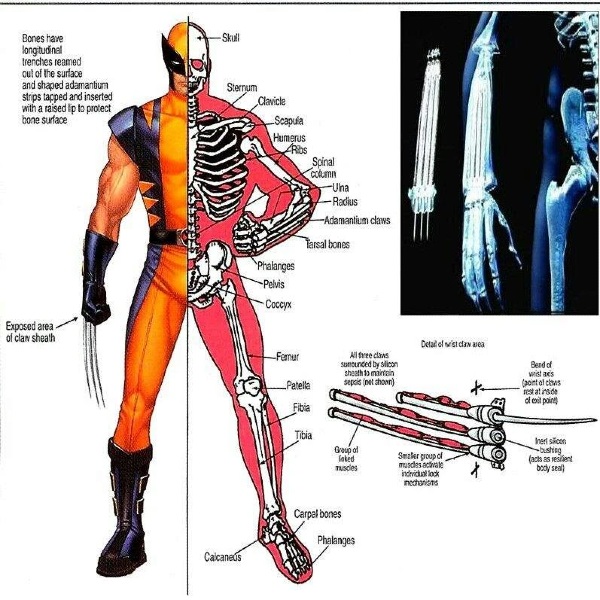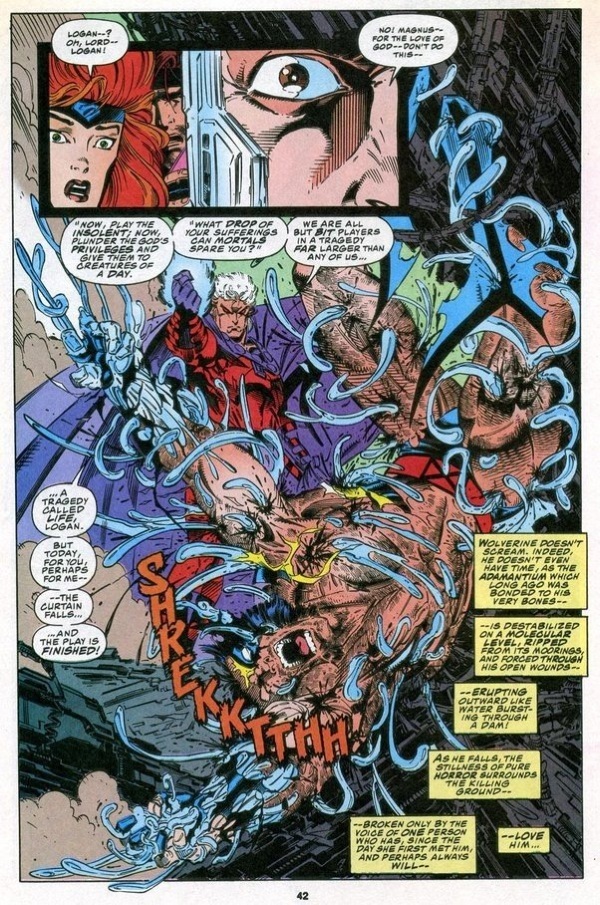What Is Wolverine’s Skeleton Made Of? Adamantium Coating Explained

Numerous fictional metals, elements, and materials are created in Marvel Comics, with various properties and varying levels of indestructibility. On the top of that list is a man-made metal alloy named adamantium, which was used on Wolverine’s skeleton to make him the hero we all know today. But is his skeleton completely made out of adamantium? If not, what is it made of? Let’s find out.
What is adamantium?
Contrary to popular belief, adamantium is not an alien metal like vibranium in Marvel Comics. It is completely man-made (although its history can be just a little bit murky) as an alloy whose molecular density is so strong that it makes adamantium nigh-impervious to any kind of damage. But we’ve seen adamantium get broken or damaged, right? So, how is this possible?
Well, it’s simple – there is more than one type of adamantium. If you want each type explained, the easiest way is to go through the history of adamantium’s creation.
In World War II, an American metallurgy expert wanted to create a unique alloy that would make US tanks more impervious to damage than any other tank. The scientist’s name was Dr. Myron MacLain, and he worked tirelessly on creating an alloy that was stronger than even the alien vibranium. That’s where we get to our first-ever, never-replicated adamantium version.
Proto-Adamantium
MacLain used steel, vibranium, chemical resins, and an unknown catalyst to create Proto-Adamantium, also known as the original Adamantium. As MacLain worked tirelessly on trying to combine steel and vibranium, he fell asleep in his lab. As he was asleep, an unknown third catalyst caused the two metals to merge, creating what is now known as Proto-Adamantium.
The mixture was molded into a disc, creating – you guessed it – Captain America’s famous shield. Dr. Maclain tried hard to replicate the process but never could figure out what caused the merging. He tried various combinations, eventually dropping vibranium from the mix completely – that’s when we got True Adamantium.
True Adamantium

Properties of True Adamantium, or Primary Adamantium, make the alloy even more dense than vibranium but incredibly hard to work with. When heated to 1500 degrees Fahrenheit (around 816 degrees Celsius), there was an 8-minute window where the mixture was liquid and malleable.
After it hardens, it can never be molded again, regardless of how much heat or pressure is applied. This form of adamantium is the form present in Wolverine. Well, sort of. We’ll get there.
Secondary Adamantium
Also known as Adamantium Steel, Secondary Adamantium came into existence after numerous feeble attempts to create a more malleable, more cost-effective version of True Adamantium. This alloy was still stronger than steel or even titanium but could bend and break under immense physical pressure or temperature.
Adamantium Beta
I’ll just mention this briefly here because I want to get into detail about it a bit further down. Basically, Adamantium Beta is what is in Wolverine’s body – it’s True Adamantium modified on a molecular level. It has the same properties as True Adamantium (i.e., nigh-indestructibility) but doesn’t interfere with natural bodily processes and purposes of bones.
Other types of adamantium
The other types aren’t really relevant to our story, but they are worth mentioning. Adamantium was also created in other universes, but none had the same indestructible properties as the one MacLain created on Earth-616.
Earth-1610 Adamantium, aka Ultimate Adamantium, was highly durable but could be destroyed much more easily with physical damage. Granted, an immense amount of damage was necessary, but for instance, the Hulk could literally tear Wolverine apart in ‘Ultimate Wolverine vs. Hulk’ #1 despite Wolverine already having an adamantium skeleton.
Earth-691’s Adamantium was much more flexible and malleable, whereas Earth-10005’s Adamantium was at least partially created from an unknown material that came to Earth via a meteor.
Is Wolverine’s skeleton completely made out of adamantium?
As we’ve mentioned before, Wolverine famously has an adamantium skeleton that makes him incredibly powerful and durable – apart from his highly potent healing factor, of course. But is his entire skeleton really made out of adamantium?
No, it’s not.
You see, Wolverine underwent brutal experiments known as the Weapon X program, where True Adamantium was injected into his body to essentially replace his skeleton. We’ve seen Wolverine use bone claws before, and we’ve seen him lose adamantium via external factors, being left behind with only bones. What does that mean?
At first, the writers planned to make Wolverine’s skeleton completely replaced by adamantium. However, fans started poking holes in that story because bones aren’t just structural components of the body. Bone marrow has an important biological function, so if it was completely wiped out and replaced with adamantium, how would Wolverine even live?
That’s where Adamantium Beta steps in. You see, it was explained that Primary Adamantium didn’t completely replace Wolverine’s bones. Instead, his healing factor allowed the metal alloy to rearrange its molecular structure in a way that allowed it to merge with his bones, essentially coating his skeleton in adamantium instead of having it become adamantium.

The newly rearranged molecular structure is known as Adamantium Beta – it has all the properties of True Adamantium in terms of its durability, but it allows the normal biological functions of Wolverine’s skeleton to continue working uninterruptedly and seamlessly.
This means Mr. Wolvie here has an adamantium-coated skeleton instead of his skeleton actually becoming adamantium. As for his claws, the bone claws were, in fact, replaced by adamantium claws instead of being coated with them.
I still have an issue with his teeth, though. I mean, the guy’s entire skeleton is coated in adamantium, and his teeth are as white as pearls. So, they coated them in adamantium and then coated them with enamel?
How can Wolverine be so agile and quick?
Another thing I saw people find confusing is Wolverine’s incredible agility and quickness. How can he be so agile and quick when his bones are literally coated in the densest metal in existence? Shouldn’t he weigh, like, a ton? Well, the answer is that he actually does weigh a ton – not literally a ton, but a lot.

Basically, we kind of disregard Wolverine’s incredible strength when speaking about his superpowers. To move at such speed, have such incredible reflexes, and perform the incredibly acrobatic moves he does while carrying all that weight requires Wolverine to be insanely strong.
That all stems from his original mutation. You see, Logan was chosen for the Weapon X experiments for a reason. His mutation already made him very strong and gave him the healing factor. And that’s not all. Had he not received the adamantium coating, he might’ve been even more dangerous than he is with it.
Would Wolverine be better off without adamantium?
Sure, the adamantium made Wolverine much more durable in combat, but did it actually make him more invulnerable – or more powerful in any way other than being capable of slicing through just about anything? It sounds crazy to suggest that he’d be better off with regular bones and claws, but bear with me.
Many mutants undergo a ‘secondary’ mutation with time like Beast permanently became the colossal furry beast after a while. The theory is that the adamantium coating actually hindered Wolverine’s secondary mutation that would have made him even more powerful – and there’s proof to hold that theory.
We know that adamantium weakened Wolverine’s healing factor, or at least slower. It manifested over time as the adamantium eventually poisoned Logan to the point where his healing factor wasn’t sufficient to keep him alive. Without the adamantium, Wolverine’s healing factor wouldn’t grow weaker, and he likely would’ve never gotten old and died.

Also, his secondary mutation wouldn’t be hindered. We saw what it looked like in a couple of storylines where the adamantium was removed from Logan’s body. His secondary mutation made Wolverine a lot stronger – but a lot more feral. He was basically becoming a superpowerful wild animal – he even licked Beast’s face once to wake him up.
That is when the X-Men helped Logan and trained him to regain his human-level consciousness. This means he held on to all the extra perks of the secondary mutation – additional strength, speed, agility, and a non-hindered healing factor – without the ‘feral’ mindset.
Sure, bones are less durable than adamantium, and Wolverine would be more vulnerable to damage. But he’d have a stronger healing factor and all the other perks of his secondary mutation that I’ve mentioned before. It makes me believe he’d be much more powerful had the adamantium never been administered to his skeleton.
And it’s not like adamantium was completely indestructible in the first place…
Can adamantium be broken or destroyed?
We already know that lesser versions of adamantium are capable of being destroyed or damaged. But can Primary Adamantium actually be destroyed, broken, or damaged? As it turns out, it can, and was, multiple times.
Once, Thor channeled all his might and struck adamantium with Mjolnir, causing a slight dent in the metal alloy. He didn’t really destroy it, but still.
Then there’s the Dragonite story – a material that rarely appears in Marvel Comics, but there was a storyline where Dragonite could pierce through solid adamantium. And then, there’s the Magneto thing.
Magneto controls magnetism and all objects with magnetic fields and properties. With adamantium being a metal alloy, Magneto could control it multiple times. There was even this storyline where Magneto altered the molecular structure of adamantium to liquify it and then extracted it completely from Logan’s body.

Basically, it’s nearly impossible to damage adamantium physically, but not impossible. Also, any hero/villain that has magnetism control, reality warping, or molecular manipulation can at least break adamantium in a way, if not destroy it completely.
Thanos had done it before, albeit with infinity stones. There were storylines where demons could break adamantium, too, and in theory, powerful reality-warpers like Franklin Richards or Scarlet Witch could literally blink it out of existence.
Yeah, I think Wolvie would’ve been better off with his bones. Have something to add? Let us know in the comments below!
Liked this article? Follow us on Facebook, Threads, and X to stay updated with the latest news.

